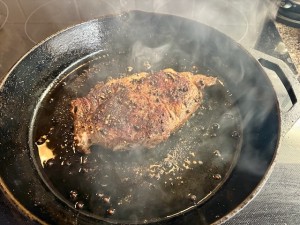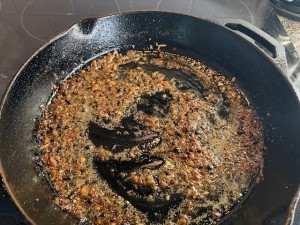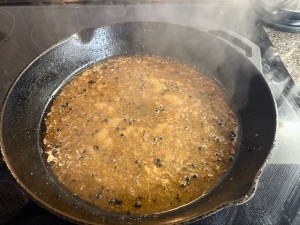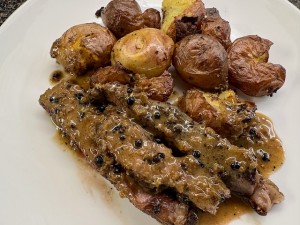Sun 16 Mar 2025
Steak au Poivre for Two
Posted by Recipe Sleuth under New Finds
[2] Comments
If you are planning a special dinner for two, try this steak au poivre from NYT Cooking. Crush peppercorns and dredge the steak in them. Sear the steak on both sides and finish cooking in the oven. Set the steak aside to rest. In the same skillet, cook the shallot, add the cognac, reduce the sauce and then add the stock. When the sauce has thickened, remove from heat, add the butter and cream and season. Slice the steak and serve with the sauce.
Avoiding Additives and Preservatives
I used Better Than Bouillon chicken paste for the stock and butter that did not contain colour.
Ingredients:
1 large (1½-inch/3.8-cm thick) boneless rib-eye (or strip) steak
3 scant tablespoons (45 ml) whole black peppercorns
Kosher salt (such as Diamond Crystal)
2 tablespoons (30 ml) canola or vegetable oil
3 tablespoons (45 ml) minced shallot (ideally as finely minced as possible)
¼ cup (60 ml) Cognac or brandy
¾ cup (180 m) chicken stock
2 tablespoons (30 ml) unsalted butter, at room temperature
1 to 2 tablespoons (15 to 30 ml) heavy cream (optional)
Preparation:
Remove the meat from the fridge and let sit for 20 minutes.
Prepare your peppercorns: Set your peppercorns on a cutting board and, little by little, using the flat side of a large chef’s knife, press a small cluster of peppercorns until they’re crushed. You can also crush the peppercorns in a mortar and pestle. Transfer to a pie dish or similar vessel.
Lightly season both sides of the meat with about ¾ teaspoon (3.75 ml) salt total. Be conservative, as you’ll be preparing a pan sauce from the meat drippings later, and you can always add salt then. Dredge the meat in the peppercorns, coating both sides.
Heat the oven to 425 degrees F (218 C), then heat the oil in a large cast-iron skillet over medium-high. Once the oil is rippling hot — it should sputter if you flick a peppercorn into it — place the meat in the pan and brown on both flat sides, about 4 minutes per side. If you have a sizable fat cap — a thick layer of white, chewy fat — on either of the smaller sides, sear them off until browned, 30 seconds to 1 minute per side. If possible, take the temperature of your meat before adding it to the oven, so you have a sense of how long it’ll need to cook.
Transfer the pan to the oven and cook to desired doneness, about 3 minutes for medium-rare (the temperature should be about 132 degrees F/55 degrees C). Remove the pan from the oven and transfer the meat to a cutting board to rest.
Add the shallot to the skillet and cook over medium-high until softened, stirring frequently, about 1 minute. Turn off the burner, then pull the hot skillet off the heat. Add the Cognac. If the reaction between the heat and alcohol produces a flame, don’t panic! It will subside in a minute.
Return to the stovetop, stir to deglaze and cook over medium-high 1 to 2 minutes, until the liquid evaporates. Add the stock and cook until thickened and saucy, 6 to 8 minutes.
When the sauce is almost done reducing, slice the steak crosswise into ½-inch (1.25-cm) slices.
Once the sauce has reduced until thick enough to coat a spoon, pull it off the heat. Whisk in the butter, then the heavy cream (if using) and season with salt and pepper. Drizzle the sauce on a serving plate and transfer the steak on top. Serve immediately. Serves 2.
From NYT Cooking




The recipe sounds absolutely delicious, and I love the attention to detail in every step. Using Better Than Bouillon chicken paste is such a great idea for enhancing the flavor of the stock. I’m curious, though, why you chose to use butter without color—does it make a noticeable difference in the final dish? The method of crushing the peppercorns with a knife seems a bit time-consuming; have you tried using a pepper grinder for convenience? The pan sauce made from the meat drippings sounds like it would be incredibly rich and flavorful. I’m also wondering if the heavy cream is essential or if it’s more of a personal preference. Would you recommend any specific brand of Cognac or brandy for this recipe? Overall, it seems like a fantastic dish, but I’d love to hear more about your experience making it—any tips or tricks you’ve discovered along the way?
Thanks for your comments! I use butter without colour because all of the recipes I post are made using ingredients without additives and preservatives, such as artificial colour, artificial flavour, sulfites, MSG, sodium benzoate, nitrites, etc. From a flavour perspective, colour in the butter would not make a difference. A pepper grinder could work if it was set on a very coarse grind; another approach would be to use a mortar and pestle. The cream adds richness and flavour to the sauce. I think any kind of cognac or brandy would work. Thanks again for your comments.